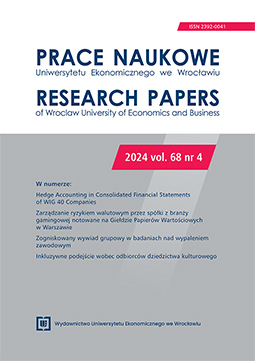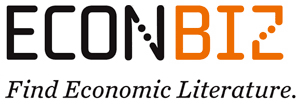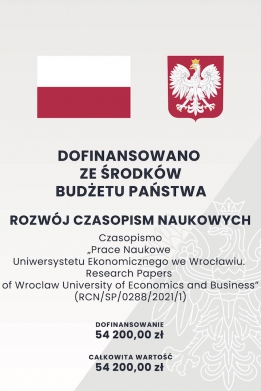Zastosowanie zogniskowanych wywiadów grupowych w badaniach nad wypaleniem zawodowym
DOI:
https://doi.org/10.15611/pn.2024.4.07Słowa kluczowe:
badania jakościowe, zogniskowane wywiady grupowe, syndrom wypalenia zawodowegoAbstrakt
Cel: Celem artykułu jest wskazanie na możliwości i ograniczenia zastosowania zogniskowanego wywiadu grupowego w badaniach dotyczących problemu wypalenia zawodowego.
Metodyka: W opracowaniu wykorzystano literaturę przedmiotu oraz wyniki badań własnych przeprowadzonych wśród czterech grup przedstawicieli pokolenia Z.
Wyniki: Analiza metodyk badań jakościowych zrealizowanych przez badaczy zajmujących się tematyką wypalenia zawodowego wskazuje, że dominującymi technikami badawczymi są indywidualne oraz grupowe wywiady pogłębione. Głównymi celami badań są zaś identyfikacja doświadczeń zawodowych przyczyniających się do wypalenia zawodowego, określenie czynników przyczyniających się do stresu i wypalenia zawodowego oraz opracowanie metod interwencji w tym zakresie.
Implikacje i rekomendacje: W artykule zawarto rekomendacje dotyczące możliwości zastosowania metodologii badań jakościowych, w szczególności zogniskowanych wywiadów grupowych, w projektach dotyczących wypalenia zawodowego. Dotyczą one zarówno projektowania przygotowywania takich badań, jak i ich realizacji.
Oryginalność/wartość: W artykule przedstawiono nowatorskie podejście polegające na analizie możliwości zastosowania zogniskowanych wywiadów grupowych w odniesieniu do wrażliwej kwestii, jaką jest syndrom wypalenia zawodowego. Wartością jest wskazanie na potencjał tej metody w kontekście uwzględnienia perspektywy pokolenia Z.
Pobrania
Bibliografia
Altinoz, M., Cop, S., Cakiroglu, D., & Altinoz, O. T. (2016). The Influence of Organization Support Perceived in Enterprises on Burnout Feeling: A Field Research. Procedia–Social and Behavioral Sciences, 235, 427–434. https://doi.org/10.1016/j.sbspro.2016.11.053
Avanzi, L., Fraccaroli, F., Castelli, L., Marcionetti, J., Crescentini, A., Balducci, C., & Dick, R. (2018). How to Mobilize Social Support against Workload and Burnout: The Role of Organizational Identification, Teaching and Teacher Education, 69, 154–167. https://doi.org/10.1016/j.tate.2017.10.001
Berg, M. J. van den, Signal, T. L., & Gander, P. H. (2020). Fatigue Risk Management for Cabin Crew: The Importance of Company Support and Sufficient Rest for Work-life Balance – a Qualitative Study, Industrial Health, 58(1), 2–14. https://doi.org/10.2486/indhealth.2018-0233
Białowąs, S., Gołata, K., Krzyminiewska, G., Olejnik, I., Shelest-Szumilas, O., Waligóra, A., & Zboroń, H., (2022). Nowe Pokolenie w Nowej Gospodarce. Raport naukowo-badawczy. Uniwersytet Ekonomiczny w Poznaniu
Bilowol, J., Robinson, J. A., Wise, D. & Sison, M. (2024). ‘Always Being On’: Exploring the Experience of Burnout Among Female Professionals in the Australian Public Relations Industry. In E. Bridgen & S. Williams (Eds.), Women’s Work in Public Relations (pp. 129–145). Emerald Publishing. https://doi.org/10.1108/978-1-80455-538-520241007
Błaszczak, A., (2024). Pokolenie Z budzi postrach wśród pracodawców. Rzeczpospolita. Retrieved April 15, 2024 from https://www.rp.pl/rynek-pracy/art40162451-pokolenie-z-budzi-postrach-wsrod-pracodawcow
Bracco, L., Váldez, R., Wakeham, N., & Velázquez, T. (2018). Professional Burnout Syndrome and Peruvian Prison Workers. A Qualitative Study of Institutional and Social Factors. Revista Colombiana de Psicología, 28(1), 13–28. https://doi.org/10.15446/rcp.v28n1.66056
Cano, Y. M., Ruiz, D. D., & Esquivel, K. C. (2023). Burnout effect on working mothers in leadership positions during the COVID-19 lockdown. Gender in Management: An International Journal, 38(7), 962–977. https://doi.org/10.1108/GM-032022-0085
Chen, Z., Sun, H., Lam, W., Hu, Q., Huo, Y., & Zhong, J. A. (2012). Chinese Hotel Employees in the Smiling Masks: Roles of Job Satisfaction, Burnout, and Supervisory Support in Relationships between Emotional Labor and Performance. The International Journal of Human Resource Management, 23(4), 826–845. https://doi.org/10.1080/09585192.2011.579918
Demerouti, E., & Bakker, A. B. (2008). The Oldenburg Burnout Inventory: A Good Alternative to Measure Burnout and Engagement. Handbook of Stress and Burnout in Health Care, 65(7), 1–25.
Demerouti, E., (2015). Strategies Used by Individuals to Prevent Burnout. European Journal of Clinical Investigation, 45(10), 1106–1112. https://doi.org/10.1111/eci.12494
Golparvar, M., & Parsakia, K. (2023). Building Resilience: Psychological Approaches to Prevent Burnout in Health Professionals. KMAN Counseling & Psychology Nexus, 1(1), 159–166. https://doi.org/10.61838/kman.psychnexus.1.1.18
Holtkamp, P., Soliman, W., & Siponen, M. (2019). Reconsidering the Role of Research Method Guidelines for Qualitative, Mixed-Methods, and Design Science Research. In Proceedings of the 52nd Hawaii International Conference on System Sciences (HICSS 2019). University of Hawaiʻi at Mānoa. http://hdl.handle.net/10125/60062
Jelen, A., Goldfarb, R., Rosart, J. Graham, L., & Rubin, B. B. (2024). A Qualitative Co-Design-Based Approach to Identify Sources of Workplace-Related Distress and Develop Well-Being Strategies for Cardiovascular Nurses, Allied Health Professionals, and Physicians. BMC Health Services Research, 24, 246. https://doi.org/10.1186/s12913-024-10669-x
Kaczmarek, M., Olejnik, I., & Springer, A., (2022). Badania jakościowe: metody i zastosowania. CeDeWu.
Kristensen, T. S., Borritz, M., Villadsen, E., Christensen, K. B. (2005). The Copenhagen Burnout Inventory: A New Tool for the Assessment of Burnout. Work & Stress, 19(3), 192–207.
Lima, S. dos S. F. de & Dolabela, M. F. (2021). Strategies Used for the Prevention and Treatment of Burnout Syndrome. European Journal of Marketing, 35(5/6). https://doi.org/10.1108/03090560110388123
Low, G. S., Cravens, D. W., Grant, K., & Moncrief, W. C. (2001), Antecedents and Consequences of Salesperson Burnout. Research, Society and Development, 10(5). https://doi.org/10.33448/rsd-v10i5.14500
Lövenmark A., & Hammar L. M. (2024). Being Used for the Greater Good while Fighting on the Frontline: Care Staff's Experiences of Working with Older People during the COVID-19 Pandemic in Sweden. BMC Geriatrics, 24(1), 135. https://doi.org/10.1186/s12877-023-04644-0
Madigan, D. J., Kim, L. E. Glandorf, H. L. (2024) Interventions to Reduce Burnout in Students: A Systematic Review and MetaAnalysis. European Journal of Psychology of Education, 39, 931–957. https://doi.org/10.1007/s10212-023-00731-3
Malach-Pines, A. (2005). The Burnout Measure, Short Version. International Journal of Stress Management, 12(1), 78.
Maslach, C., Schaufeli, W. B., & Leiter, M. P. (2001). Job Burnout. Annual Review of Psychology, 52(1), 397–422.
Maslach C., Jackson S. E. (1981). The Measurement of Experienced Burnout, Journal of Organizational Behavior, 2(2), 99–113. https://doi.org/10.1002/job.4030020205
Melnikow, J., Xing, G., Miller, M. E., Loureiro, S., Padovani, A. J., Whitney, R., & Kravitz, R. L. (2024). Workplace Support for Physicians during the COVID-19 Pandemic: Did it Affect Burnout?. BMC Health Services Research, 24(1), 888.
Michalak, S., & Olejnik, I. (2023). Burnout and Ways of Preventing It: A Qualitative Analysis. Zeszyty Naukowe Uniwersytetu Ekonomicznego w Krakowie, 2(1000), 87–103. https://doi.org/10.15678/ZNUEK.2023.1000.0205
Miles, M., & Huberman, A. M. (1994). Qualitative Data Analysis. Sage.
Miller-Keane. (n.d.) Burnout. In Miller-Keane Encyclopedia and Dictionary of Medicine, Nursing, and Allied Health, Seventh Edition. Retrieved August 22, 2024 from https://medical-dictionary.thefreedictionary.com/burnout
Oksa, R., Saari, T., Kaakinen, M., & Oksanen, A. (2021). The Motivations for and Well-Being Implications of Social Media Use at Work among Millennials and Members of Former Generations. Int. J. Environ. Res. Public Health, 18, 803. https://doi.org/10.3390/ijerph18020803
Olejnik, I. (Ed.) (2021). Qualitative and Quantitative Methods in Sustainable Development. Wydawnictwo Uniwersytetu Ekonomicznego w Poznaniu. https://doi.org/10.18559/978-83-8211-072-2
Osei, H.V., Arthur, J., Aseibu, F., Osei-Kwame, D., Fiakeye, R., & Abama, C. (2024). The joint impact of burnout and neurotic personality on career satisfaction and intention to leave among health workers during the first 2 years of COVID-19. Journal of Health Organization and Management, 38(5), 621–637. https://doi.org/10.1108/JHOM-03-2023-0089
Prochnow, T., Oglesby, L., Patterson, M. S., & Umstattd Meyer, M. R. (2020). Perceived Burnout and Coping Strategies among Fitness Instructors: A Mixed Methods Approach. Managing Sport and Leisure, 27(5), 484–498. https://doi.org/10.1080/23750472.2020.1825986
Saldana, J. (2021). The Coding Manual for Qualitative Researchers. Sage.
Santiago-Torner, C., Corral-Marfil, J. A., & Tarrats-Pons, E. (2024). Relationship between Personal Ethics and Burnout: The Unexpected Influence of Affective Commitment. Administrative Sciences, 14(6), 123. https://doi.org/10.3390/admsci14060123
Sarros, J. C., & Sarros, A. M. (1987). Predictors of Teacher Burnout, Journal of Educational Administration, 25(2), https://doi.org/10.1108/eb009933
Schaufeli, W. B., & Greenglass, E. R. (2001). Introduction to Special Issue on Burnout and Health. Psychology and Health, 16, 501e510. https://doi.org/10.1080/08870440108405523
Schaufeli, W. B., & Enzmann, D. (2020). The Burnout Companion to Study and Practice. A Critical Analysis. Taylor & Francis. https://doi.org/10.1201/9781003062745
Shanafelt, T.D., Gorringe, G., Menaker, R., Storz, K. A., Reeves, D., Buskirk, S. J, Sloan, J. A., & Swensen, S. J. (2015). Impact of Organizational Leadership on Physician Burnout and Satisfaction. Mayo Clin Proc., 90(4), 432–440. https://doi.org/10.1016/j.mayocp.2015.01.012
Soklaridis, S., Zaheer, R., Scully, M., Shier, R., Williams, B., Dang, L., Sam, D., Sanjeev S., & Tremblay, M. (2024). ‘We Are in for a Culture Change’: Continuing Professional Development Leaders’ Perspectives on COVID-19, Burn-out and Structural Inequities. BMJ Leader, 8(2), 142–1461. https://doi.org/10.1136/leader-2023-000837
Stefańska, M., & Olejnik, I. (2021). Dobór próby i analiza wyników w badaniach jakościowych. In M. Rószkiewicz, K. Mazurek-Łopacińska, A. Sagan (Eds.), Dobór próby we współczesnych badaniach marketingowych. Podejścia ilościowe, jakościowe i mieszane (pp. 59–74). Wydawnictwo Uniwersytetu Szczecińskiego.
Sullivan, E. E., Etz, R. S., Gonzalez, M. M., Deubel, J., Reves, S. R., Stange, K. C., Hughes, L.S., & Linzer, M. (2024). You Cannot Function in “Overwhelm”: Helping Primary Care Navigate the Slow End of the Pandemic. Journal of Healthcare Management, 69(3), 190–204. https://doi.org/10.1097/JHM-D-23-00102
Taka, F., Nomura, K., Horie, S., Takemoto, K., Takeuchi, M., Takenoshita, S., Murakami, A., Hiraike, H., Okinaga, H., & Smith, D. R. (2016). Organizational Climate with Gender Equity and Burnout among University Academics in Japan. Industrial Health, 54, 480–487. https://doi.org/10.2486/indhealth.2016-0126
Tahar, Y. B., Rejeb, N., Maalaoui, A., Kraus, S., Westhead, P., & Jones, P. (2023). Emotional Demands and Entrepreneurial Burnout: The Role of Autonomy and Job Satisfaction. Small Business Economics, 61(2), 701–716. https://doi.org/10.1007/s11187-022-00702-w
Tan, K. L., Lew, T. Y., & Sim, A. K. S. (2021). Effect of Work Engagement on Meaningful Work and Psychological Capital: Perspectives from Social Workers in New Zealand, Employee Relations, 43(3), 807-826. https://doi.org/10.1108/er-112019-0433
Teo, S. T. T., Nguyen, D., Shafaei, A., & Bentley, T. (2021). High Commitment HRM and Burnout of Frontline Food Service Employees: A Moderated Mediation Model, Employee Relations, 43(6), 1342-1361. https://doi.org/10.1108/er-06-20200300
Vanheule, S., & Verhaeghe, P. (2004). Powerlessness and Impossibility in Special Education: A Qualitative Study on Professional Burnout from a Lacanian Perspective, Human Relations, 57(4), 497–519. https://doi.org/10.1177/0018726704043897
Wu, S., Li, H., Zhu, W., Lin, S., Chai, W., & Wang, X. (2012). Effect of Work Stressors, Personal Strain, and Coping Resources on Burnout in Chinese Medical Professionals: A Structural Equation Model, Industrial Health, 50(4), pp. 279-287. https://doi.org/10.2486/indhealth.MS1250
Pobrania
Opublikowane
Numer
Dział
Kategorie
Licencja
Prawa autorskie (c) 2024 Iwona Olejnik, Sylwia Michalak

Utwór dostępny jest na licencji Creative Commons Uznanie autorstwa – Na tych samych warunkach 4.0 Miedzynarodowe.
Accepted 2024-11-14
Published 2024-12-13









